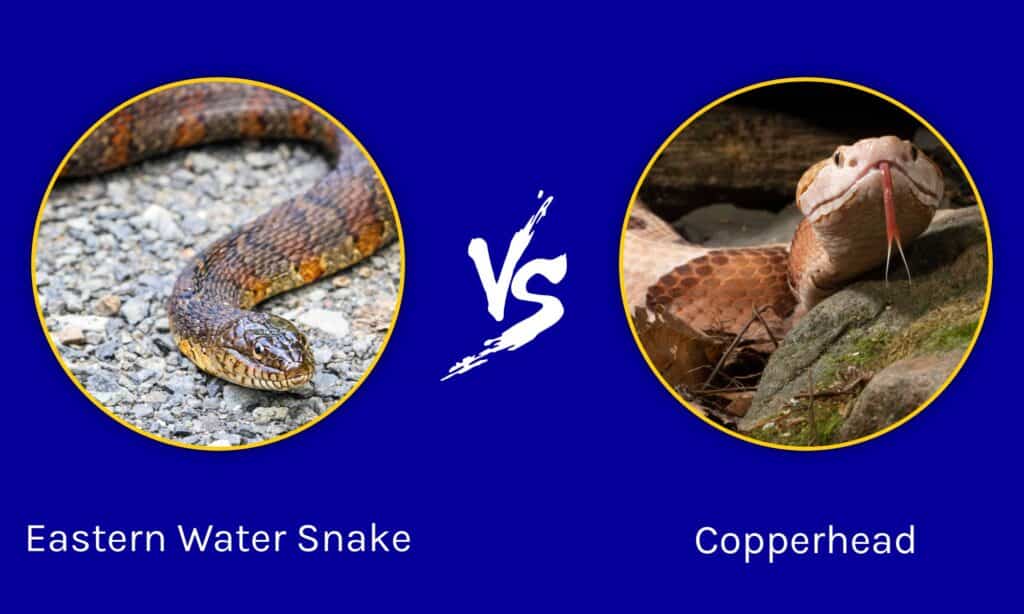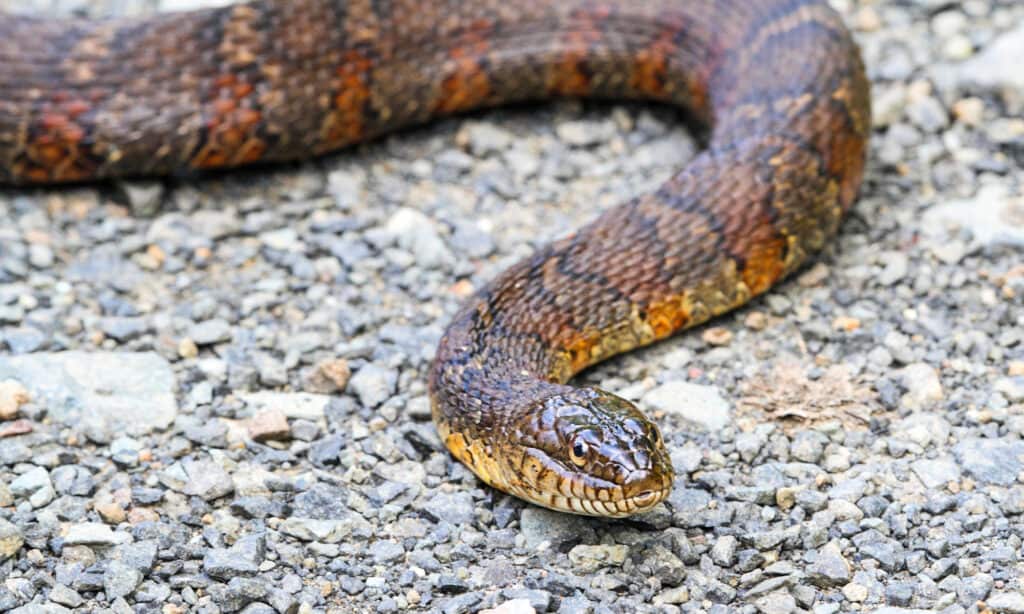Eastern water snake (Nerodia sipedon) is another name for the common water snake, which has four subspecies: Northern watersnake, Lake Erie watersnake, Midland watersnake, and Carolina watersnake. They are a species of large, nonvenomous snake native to North America, sometimes mistaken for the similar-looking copperhead snake, a venomous species of pit viper also within their range.
Because of their similarity in coloration and pattern with this dangerous species, harmless eastern water snakes are often killed indiscriminately out of fear. This article compares these two species and looks into their differences.
Comparing Copperheads and Eastern Watersnakes

| Copperhead Snake | Eastern water snake | |
|---|---|---|
| Coloration | Pale tan to pinkish-tan ground color overlaid with pale crossbands | Brown, gray, reddish, or brownish-black ground color with dark crossbands. Color darkens as the snake ages |
| Pattern | Hourglass-shaped or Hershey kiss pattern | Bulb-shaped pattern |
| Head shape | Triangular-shaped head | Narrow, slightly rounded head |
| Eyes | Slit-shaped pupils (cat-like eyes) | Round pupils |
| Size | Length: 1.7- 3.1 ft Weight: 3.2- 12.0 ounces | Length: 2.2 to 4.4 ft Weight: 2.85 to 20 ounces |
| Habitat | Deciduous forests, mixed woodlands, rocky outcroppings, low-lying swamp regions. | Streams, lakes, and ponds, and wetlands |
| Defense | Venom Tail vibration | Non-venomous bite Musk |
| Venom | Venomous to humans; Venom is primarily hemotoxic | Not venomous to Humans |
| Fangs | Solenoglyphous fangs They subdue prey with venom before swallowing them whole | No fangs. They have rows of teeth instead. |
Key Differences Between the Copperhead vs. Eastern watersnake
The main difference between an eastern water snake and a copperhead is that copperheads are venomous snakes with the physical characteristics of pit viper snakes and the pattern of their crossbands is hourglass-shaped, while eastern copperheads are nonvenomous and have bulb-shaped crossbands. Copperheads also occupy a wider range of habitats than water snakes. Let’s examine the different features of both species.
Copperhead vs Eastern Watersnake: Coloration
The body of the copperhead snake consists of a pale tan to pinkish-tan ground color overlaid with a series of pale crossbands. These crossbands are light tan to pinkish-tan to pale brown in the center but darker towards the edges. The belly of the copperhead is almost the same as the ground color.
In contrast, the eastern water snake can be brown, gray, reddish, or brownish-black. It has dark crossbands on the neck and dark blotches on the rest of the body. As the water snake ages, the color darkens. The belly also ranges from white to yellow or gray, usually with reddish or black crescents.
Copperhead vs Eastern watersnake: Pattern

Copperheads have dark-colored hourglass-shaped patterns.
©Joe McDonald/Shutterstock.com
Another easy way to differentiate between copperheads and eastern water snakes is by looking at their patterns. Copperheads have dark-colored hourglass-shaped patterns, while the eastern water snake has a bulb-shaped pattern that widens in the center. The bands on the eastern water snake go round across its body and are usually much thicker than the Hershey kiss (hourglass shape) of copperhead bands, which may be broken or do not connect. In addition, the pattern on the eastern water snake appears narrow on the sides and wide near the backbone, unlike the copperhead, whose pattern is wide on the sides and narrow near the backbone.
Copperhead vs Eastern Watersnake: Head

Eastern water snakes have a head that is narrow, slightly rounded, and in line with their body.
©Steve Byland/Shutterstock.com
Another way to differentiate these two snakes is by looking at the shape of their heads. Copperheads, like most venomous snakes, have triangular-shaped or arrow-shaped heads with heat-sensing pits. Their heads are copper-colored (hence their name) and are more broad and distinct from the neck. In comparison, eastern water snakes have a head that is narrow, slightly rounded, and in line with their body, with a neck almost as wide as the head.
Copperhead vs Eastern Watersnake: Eyes

Copperheads have slit-shaped pupils.
©Dennis W Donohue/Shutterstock.com
“Eyes don’t lie” is a phrase that also applies to identifying snakes because you can tell a lot by looking at a snake’s eyes. Venomous snakes, including copperheads, have slit-shaped pupils that look like a cat’s eye, while non-venomous snakes, including eastern water snakes, have round pupils. However, it’s virtually impossible to differentiate these snakes by this method without getting too close, so you may try using binoculars or other safer methods.
Copperhead vs Eastern Watersnake: Size

Adult eastern water snakes are larger than copperheads.
©samray/Shutterstock.com
Copperheads and eastern water snakes differ in size, both in terms of length and body weight. An adult copperhead grows to a typical length (including tail) of 1.7- 3.1 ft, while an adult eastern water snake is larger, about 2.2 to 4.4 ft in total length. Also, looking at their weight, copperheads weigh from 3.2- 12.0 ounces, while eastern water snakes can range from 2.85 to 20 ounces. Given this, eastern water snakes are longer and heavier than copperheads.
Copperhead vs Eastern Watersnake: Habitat
Copperheads and eastern water snakes are found throughout North America and near water bodies across their range. However, copperheads occupy a variety of different habitats than eastern water snakes. They are found in mixed woodlands, deciduous forests, rocky outcroppings, and low-lying swamp regions. Meanwhile, the eastern water snake is restricted to streams, lakes, ponds, and wetland habitats.
Copperhead vs Eastern watersnake: Defensive Behavior
When defending themselves from perceived danger, copperheads and eastern water snakes display different behaviors. The eastern water snake defends itself by biting repeatedly and releasing excrement and musk. Its saliva contains a mild anticoagulant, which can cause the bite to bleed more, though this poses little risk to humans. Copperheads, on the other hand, are venomous snakes that exhibit defensive tail vibration behavior when closely approached. They can vibrate their tail more than 40 times per second— faster than almost any non- rattlesnake snake.
Copperhead vs Eastern Watersnake: Venom
The major difference between copperheads and eastern water snakes is that copperheads are venomous while eastern water snakes are not. Copperheads have an estimated lethal dose of about 100 mg, but they inject a relatively small amount of their hemotoxic venom – which is why bites are rarely fatal. They are responsible for most snake bites in the United States.
According to Mayo Clinic, their bite symptoms include extreme pain, swelling, tingling, severe nausea, and damage to muscle and bone tissues when the outer extremities are bitten. On the other hand, eastern water snakes are nonvenomous harmless snakes. Though they can inflict a painful bite to defend themselves when threatened, bites from water snakes may not require medical attention, unlike the bite of a copperhead.
Copperhead vs Eastern Watersnake: Fangs
As expected of pit viper snakes, copperheads have fully functional fangs capable of injecting venom into prey to subdue them before swallowing them whole. Generally, venomous snakes have movable fangs that can retract into their head, while nonvenomous snakes like the eastern water snake have rows of fixed teeth instead of fangs. Copperheads are solenoglyphous, meaning that the size of their fangs is directly proportional to the snake’s size – The bigger the snake, the bigger the fangs!
The photo featured at the top of this post is © Wildvet/Shutterstock.com
Discover the "Monster" Snake 5X Bigger than an Anaconda
Every day A-Z Animals sends out some of the most incredible facts in the world from our free newsletter. Want to discover the 10 most beautiful snakes in the world, a "snake island" where you're never more than 3 feet from danger, or a "monster" snake 5X larger than an anaconda? Then sign up right now and you'll start receiving our daily newsletter absolutely free.
Thank you for reading! Have some feedback for us? Contact the AZ Animals editorial team.






